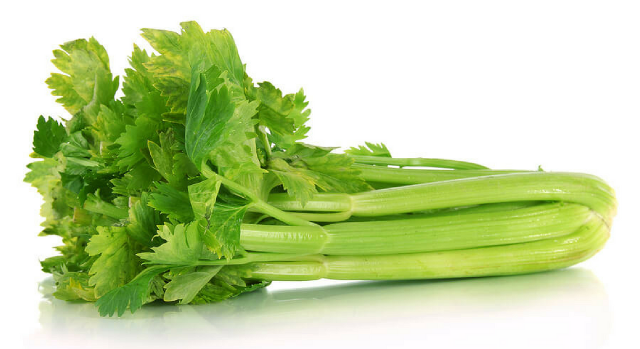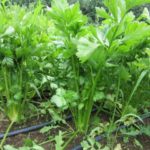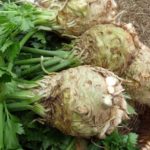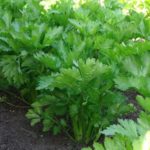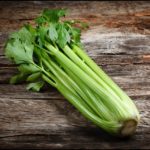Celery fragrant - spicy vegetable, which came from the Mediterranean countries. On the content of vitamins and beneficial trace elements it occupies one of the leading positions among vegetables. Due to the high content of essential oils, the dishes and salads give a specific bright aroma. All parts of the plant are eaten both raw and processed. And in this article we will examine the types of celery and how to clean it properly.
Table of contents
Celery types and characteristics
Scented Celery - biennial herbaceous plant, in appearance of the leaves is very similar to parsley, only much more massive. In the first year, the plant forms a powerful rosette of dark green leaves with beautiful gloss, fleshy cuttings and a strong white root or even a root crop. In the second year, green leaves appear in early spring, and by mid-July, the plant is already blooming, in August the seeds ripen and the celery dries almost immediately.
The appearance of celery depends on the variety to which it belongs: leafy, petiolate, root.

Celery leaves are grown to produce fragrant greens.saturated with plenty of vitamins. It is eaten fresh, in salads, as a seasoning for soups and other dishes.
Celery celery is cultivated to produce petioles and leaves. Petioles reach a width of 4-5cm, very juicy, oily, contain a large amount of essential oils, vitamins, minerals. Of these, the first and second courses are prepared, dietary low-calorie salads, added to pickles and preservation to give a spicy, bright flavor and a pleasant taste.
Celery Root grown exclusively because of the root, similar to large beets of white color and reaching from 500 to 900 grams of weight. Root - a real storehouse of vitamins, has a beneficial effect on the human body. It is used both in fresh form and in salads and hot dishes.
- Scented Celery
- Celery Root
- Leaf celery
- Stalked celery
Useful and harmful properties of stems and roots
Steamed celery is the most valuable food and has amazing healing properties. All the useful qualities of a vegetable would have to be listed for too long, but the most basic ones are: beneficial effects on the nervous, cardiovascular, digestive systems.
The useful vegetable contains a large amount of proteins, vitamins of group B, carotene, vitamins E, K, C, valuable amino acids - nicotine, asparagine, tyrosine, essential oils, trace elements - potassium, phosphorus, calcium, magnesium, zinc, iron, manganese.
Celery has the following effects on the human body:
- slows the aging process, helps fight senile dementia;
- helps to restore the water-salt balance;
- essential oils relieve nervous tension, increase efficiency, vitality, resistance to stress;
- beneficial effect on the walls of blood vessels, thereby restores blood circulation and normalizes high blood pressure;
- due to the high content of vital minerals, vitamins B, PP, E, C has a positive effect on the condition of the skin, hair, lips and eyes;
- root crop has a diuretic effect; daily consumption cleans the kidneys and urinary canals;
- salads from raw vegetables with the addition of grated root vegetables should be consumed during diets, people with diabetes, vegetarians;
- regular consumption of celery greens relieves heartburn, flatulence, constipation, stomach cramps, as it contributes to the digestion of food and removes toxins from the body.
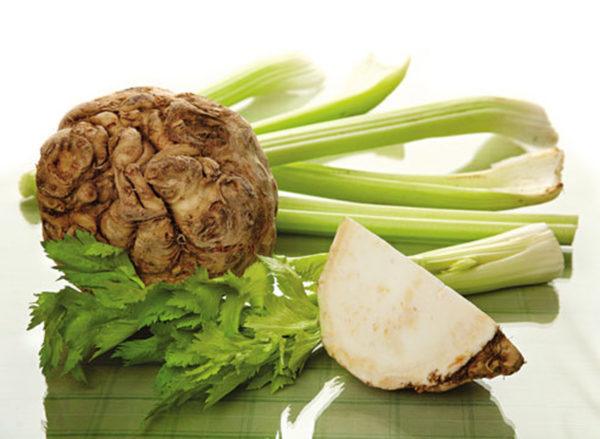
This is not all beneficial features miracle vegetable.
But such a strong therapeutic agent may not be equally useful for everyone, therefore, there are contraindications:
- with urolithiasis in order to avoid the movement of stones and exacerbation of the disease;
- with varicose veins, the presence of blood clots;
- due to the high content of essential oils is not recommended during pregnancy and lactation, with colitis and enterocolitis.
How to eat a stem vegetable
All parts of the plant are equally useful and applicable in food. But since most of the essential compounds, vitamins and trace elements are destroyed during the heat treatment process, celery is eaten raw, cleaned beforehand. Young green leaves - as a seasoning for salads, fish and meat dishes.
How to peel the stalks
Juicy, crunchy, fragrant flesh of petioles is an excellent ingredient for salads, appetizers, sauces. But not many people know that in order to fully enjoy the taste and aroma of green stems, they must be thoroughly cleaned.
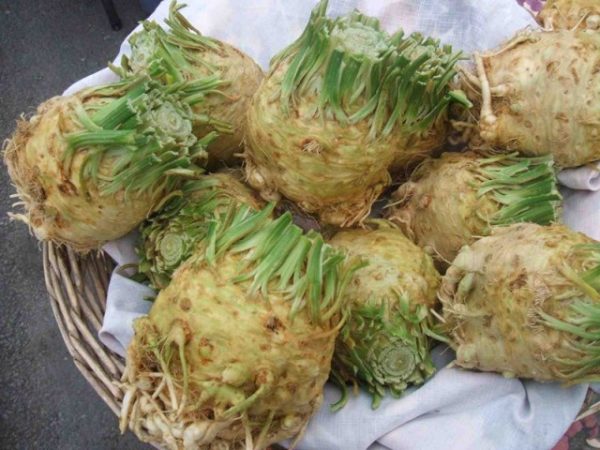
The top layer of petioles consists of hard, long fibers that make it difficult to chew the vegetable.. Therefore, before eating, cutting into salads, etc.you need to cut the top layer with a regular or economy knife.
Ways to cook properly
The dishes of petioles and celery root may not be so rich in vitamins and fiber, but they will certainly have a savory taste and aroma. Vegetable is used for cooking soups, vegetable stews, side dishes, as a filler or additive to sauces. It can be boiled, stewed or fried in sunflower or olive oil.
Without a doubt, celery is exactly that vegetable that should be constantly on our table in any form. Such a useful product can not be excluded from the diet. According to doctors, nutritionists, daily use of the product will have a positive effect on the entire body, the work of internal organs, the condition of hair, nails and skin.
